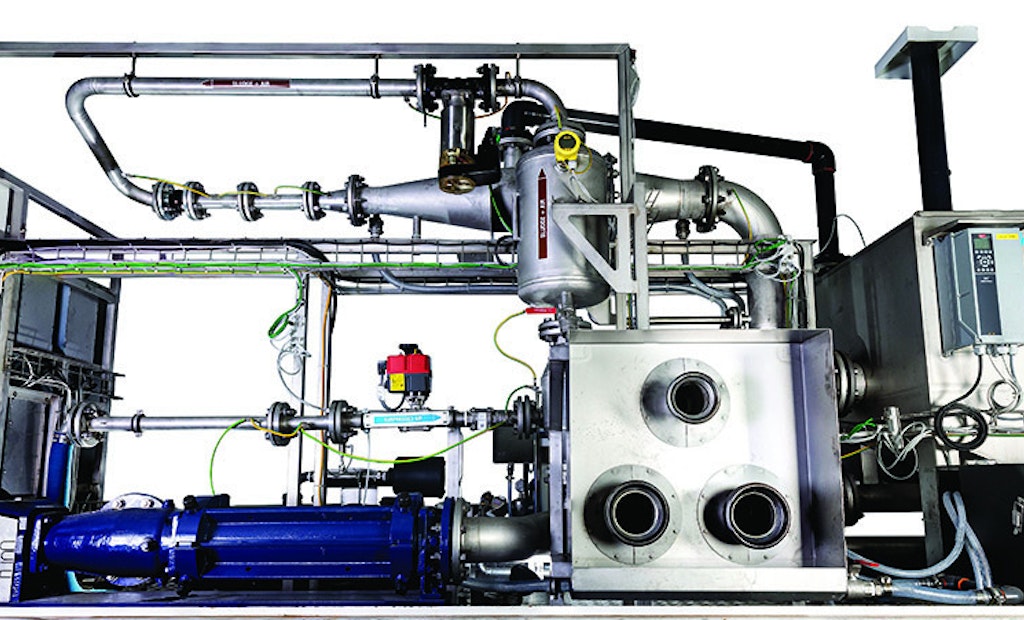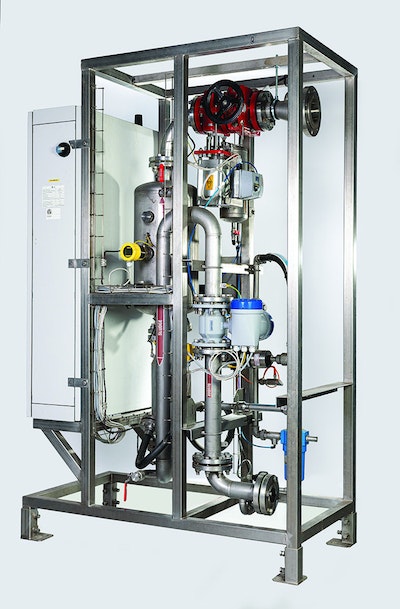
A complete SLG-F thickening skid, deployable in an 8-by-20-foot space, includes feed pumps, SLG conditioning, polymer preparation, FloSep thickening, and thickened solids pumping.
Interested in Dewatering/Biosolids?
Get Dewatering/Biosolids articles, news and videos right in your inbox! Sign up now.
Dewatering/Biosolids + Get AlertsSolids management can rank among a clean-water plant’s biggest expenses. In particular, the hauling of liquid biosolids for land application or other purposes can entail substantial and continuing costs.
Orege, a French company with operations in the United States, England and Italy, offers technologies that enhance the thickening of sludges and the dewatering of biosolids. Its SLG process is designed to optimize solids conditioning by modifying the material’s physio-chemical and rheological (deformation and flow) properties. The aim is to improve clean-water plants’ overall performance, reduce solids volumes, and lower operating costs.
Material conditioned in an SLG unit is more easily dewatered on a belt or screw press; the SLG process achieves an increase of 1.5 to 3 percentage points in dewatered cake solids. This helps reduce hauling costs and can make operation of a downstream dryer more economical.
Taking the process farther, the SLG-F process combines SLG conditioning with the company’s Flosep thickener, designed for quick solid/liquid separation in a reduced footprint. It is installed upstream of digesters to improve their performance or after digestion to reduce the volume of biosolids transported. Eddie Johnson, CEO of Orege North America, talked about the technologies in an interview with Treatment Plant Operator.
TPO: What is the basic history of development of these technologies?
Johnson: The SLG is the cornerstone of Orege’s technology to improve thickening, dewatering and anaerobic digestion processes. We knew it could enable increased solids concentration when deployed ahead of a dewatering system by way of the rheology changes to the material. As we looked at the market, we decided to offer our own thickening technology and so we developed the SLG-F.
TPO: Where was the SLG-F first deployed?
Johnson: We first brought them to market in the United Kingdom, where there are small wastewater treatment plants all over the country that do tremendous amount of liquid biosolids hauling. We provided a mobile thickening unit that enables those facilities to reduce the number of tankers they put on the road.
TPO: What is the impact of SLG and SLG-F on creating a good-quality product for beneficial use?
Johnson: The SLG improves cake dryness that a dewatering press produces, and so reduces the cost of hauling the material. It also generally reduces polymer consumption. Another benefit is the aesthetic and handling quality of the cake is much better. It’s more porous, it’s more friable, and it has more soil-like characteristics. Through conditioning with the SLG, customers get a cake that is more consistent, stacks better, and overall is easier to handle.
TPO: Can these technologies be used ahead of a biosolids dryer?
Johnson: Definitely. Biosolids have to be dewatered to a certain level to make a dryer a good economic investment. The higher the solids before the dryer, the less water the dryer has to remove. If we can increase cake dryness by two percentage points, such as from 16% to 18% solids, the volume of water the dryer has to remove is substantially decreased, and that improves dryer economics and operational conditions.
TPO: How much more moisture can you typically remove with a belt press or screw press after conditioning in the SLG?
Johnson: We typically achieve a 1.5 to 3 percentage point increase in cake dryness. However, we focus more on annual savings than a specific number for cake dryness improvement. The annual operations savings are driven by higher cake dryness and polymer reduction.
TPO: In basic terms, how does the SLG process operate to improve dewatering?
Johnson: We place the SLG between the sludge feed pump and the dewatering equipment. We first reduce the pipe diameter and measure the flow and pressure in the pipe. Next, we increase the velocity of the material and inject compressed air using an air-to-sludge ratio between 1 and 10. At this stage the naturally occurring flocs bound together with EPS (extra polymeric substance) are broken down, reducing the particle size. Then the air entrained liquid sludge enters the reactor and after the reactor there is a valve that maintains the entire system under back pressure. Polymer is injected after the SLG and the flocculated sludge is then dewatered.
TPO: What happens after the air injection stage?
Johnson: The material exits the injector and enters the reactor, which is a larger vessel where the velocity slows down, allowing the air to expand. There’s no heat or power in this step; it’s just a vessel.
TPO: What happens to this material before it is fed to the dewatering device?
Johnson: Between the SLG and the dewatering step we add polymer, and the material goes through a deaerator. The air coming out of the deaerator can be piped directly into the facility’s odor-control system so that odor-causing gases are not expelled into the building.
TPO: What are characteristics of the product coming out of the SLG?
Johnson: The solids content coming out is the same as the solids content going in. There’s no mass change. There is no heat or chemical treatment in the SLG. After flocculation the material will exhibit a rapid solid/liquid separation and floats.
TPO: How does the process work in the SLG-F configuration?
Johnson: The SLG process works exactly the same, but instead of being connected to a dewatering device, the material leaving the deaerator goes into the feed tank for the Flosep thickener and almost immediately floats up in that tank. We’ve had people call the SLG-F a mini-DAF or a rapid DAF. The floated material gets picked up by a rotating wire screen drum.
TPO: What solids content can the SLG-F achieve?
Johnson: Waste activated sludge 6%, primary/waste activated blends greater than 6%, primary only greater than 7%. We also can add pressure to the drum to achieve higher solids while maintaining excellent capture rates.
TPO: Can you cite examples of facilities that are using your SLG-F technology?
Johnson: One plant in South Carolina has an aerobic digester and traditionally has two to six biosolids haul events per year. They use the SLG-F to thicken the material before haul events. It cuts the amount of liquid they haul off in half. It provides a two-year payback. Another client in Arizona has the same basic application.
A client in Wisconsin is thickening ahead of anaerobic digestion. In the U.K., customers have installed the SLG-F before anaerobic digestion and have reported an increase in their biogas production of 30% and greater. The technology consistently produces thickened material at 6% solids or greater. The units have replaced gravity belt thickeners and rotary drums.
TPO: What is the advantage of thickening upstream of digesters?
Johnson: The benefits are reduction of the hydraulic load on the digesters and increased solids retention time, along with improved pumping of thicker solids. The SLG-F also improves methane gas production for anaerobic digesters.
TPO: What other benefits does your technology provide?
Johnson: The footprint of our system is smaller than for traditional thickeners. Our complete SLG-F thickening skid can be set down in an existing plant in an 8-by-20-foot area. The skid includes feed pumps, SLG conditioning, polymer preparation, FloSep thickening and thickened solids pumping. It’s also a very simple and low-maintenance system. There are very few moving parts. It’s a hands-off, fully automated process.






